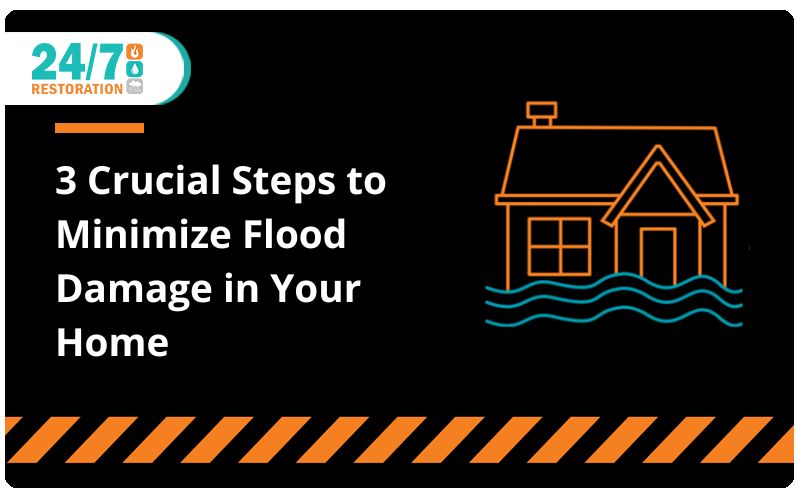Flooding is a distressing event that can cause significant damage to homes, especially in Calgary, where weather patterns can sometimes be unpredictable. The emotional and financial toll of flood damage can be overwhelming, but taking proactive steps can help minimize the impact. At 24/7 Restoration Calgary, we understand the importance of protecting your home and peace of mind. Here are three crucial steps to minimize flood damage in your Calgary home.
1. Implement Preventative Measures
Preventing flood damage starts with taking proactive measures to safeguard your home. Here are some effective strategies to consider:
Install a Sump Pump: A sump pump is essential for homes in flood-prone areas. It helps to remove water that accumulates in your basement, preventing it from rising to damaging levels. Ensure your sump pump is in good working condition and consider installing a battery backup in case of power outages during storms.
Seal Cracks and Gaps: Inspect your home’s foundation, walls, and windows for any cracks or gaps that could allow water to seep in. Use waterproof sealants to fill these gaps and prevent water infiltration. Pay special attention to basement windows and doors, as these are common entry points for floodwater.
Grade Your Yard: Proper yard grading can help direct water away from your home. Ensure that the ground slopes away from your foundation, so rainwater naturally flows away from your house. This simple landscaping adjustment can make a significant difference in preventing water from pooling around your home.
Install Backflow Valves: Backflow valves prevent sewage from backing up into your home during heavy rains or floods. These valves are particularly important if your home is connected to a municipal sewer system. Consult with a professional plumber to install backflow valves in your drains and sewer lines.
2. Create an Emergency Plan
Having a well-thought-out emergency plan can significantly reduce the chaos and damage that can occur during a flood. Here’s what to include in your plan:
Identify Safe Zones: Determine the safest areas in your home where you and your family can go during a flood. Ideally, these should be upper floors or areas that are least likely to be affected by rising water.
Prepare an Emergency Kit: Assemble an emergency kit that includes essential items such as bottled water, non-perishable food, flashlights, batteries, first aid supplies, important documents, and any necessary medications. Keep this kit in an easily accessible location.
Establish Communication Plans: Ensure all family members know how to communicate during an emergency. Designate a meeting point outside your home and have a list of emergency contacts, including local authorities and 24/7 Restoration Calgary.
Know How to Shut Off Utilities: Familiarize yourself with the location of your home’s main water, gas, and electricity shut-off valves. In the event of a flood, turning off these utilities can prevent further damage and reduce safety hazards.
3. Respond Quickly to Flood Warnings
When flood warnings are issued, time is of the essence. Quick and decisive action can help minimize damage to your home:
Move Valuables to Higher Ground: If you have time before the flood waters reach your home, move valuable items, important documents, and electronics to higher levels. This step can help protect your most important possessions from water damage.
Sandbag Entry Points: Use sandbags to block doorways, basement windows, and other entry points where water could enter your home. This can help reduce the amount of water that gets inside and mitigate potential damage.
Follow Evacuation Orders: If local authorities issue evacuation orders, follow them immediately. Your safety is the top priority, and leaving the area can prevent you from being trapped by rising waters. Remember to take your emergency kit and any important items with you.
Contact Professional Help: As soon as it’s safe to do so, contact 24/7 Restoration Calgary for professional flood damage assessment and repair. Our team is ready to respond quickly and help you navigate the recovery process, minimizing further damage and restoring your home as efficiently as possible.
Flooding can be a daunting challenge, but by implementing preventative measures, creating an emergency plan, and responding quickly to flood warnings, you can significantly reduce the impact on your Calgary home. At 24/7 Restoration Calgary, we are dedicated to helping homeowners protect their properties and recover swiftly from flood damage. By taking these crucial steps, you can safeguard your home and ensure a quicker, smoother recovery process. Don’t wait until it’s too late—start preparing today to minimize the effects of potential flooding and keep your home and family safe. For expert advice and assistance, call or contact 24/7 Restoration Calgary for your free consultation. We’re here to help you every step of the way.
FAQs
Q: What are the most effective preventative measures to protect my Calgary home from flood damage?
A: Effective measures include installing a sump pump, sealing cracks and gaps, grading your yard to direct water away from your home, and installing backflow valves to prevent sewage backups.
Q: Why is a sump pump important for preventing flood damage?
A: A sump pump helps remove excess water from your basement, preventing it from rising to damaging levels. A battery backup ensures it works during power outages.
Q: How can I identify and seal cracks and gaps in my home?
A: Inspect your foundation, walls, and windows for any openings. Use waterproof sealants to fill these gaps, paying special attention to basement windows and doors. Not sure? Call us for a free consultation.



.png)
